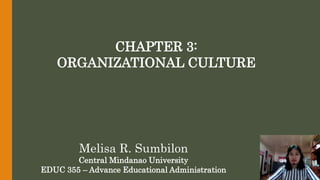
EDUC355_Chapter 3. Organizational Culture.pptx
- 1. CHAPTER 3: ORGANIZATIONAL CULTURE Melisa R. Sumbilon Central Mindanao University EDUC 355 – Advance Educational Administration
- 2. -Organizational culture is a social knowledge -Values, norms, beliefs are present in the organization Organizational culture aids in shaping employees’ behaviors ORGANIZATIONAL CULTURE
- 3. Characteristics of Organizational Culture Innovation and risk-taking Meticulousness Result orientation People orientation Team orientation Competitiveness Stability
- 4. Levels of Organizational Culture Edgar Schein the three levels of organizational culture (The Onion Model):
- 6. Functions of Culture Communication Perception Identity Value systems Motivation Stratification Production and consumption
- 9. School Culture School culture is defined • As the common values and beliefs, the signs and symbols, and the understanding shared among the members of a school (Karadag & Oztekin-Bayir, 2018). • Grunert, (2005) describes school culture as the guiding beliefs, assumptions and expectations that are apparent from how a school function. • The shared norms, values, beliefs, and traditions form the personality of a school that influences the behaviours of school leaders, teachers, and students (Karadag, Kilicoglu & Yilmas, 2014).
- 10. School Culture School culture is defined • It reflects the deep patterns of values, beliefs and traditions accumulated over time. Although schools have similar structures, every school is unique, having its own symbols, artefacts, traditions, and customs that shape the values, norms, and beliefs of those who belong to that school (Horton, 2018). • Accordingly, every school has its own distinctive culture. In order to understand an organization, it is necessary to focus on the unique culture of each organization (Kalman & Balkar, 2018).
- 11. School Culture
- 12. School Culture
- 13. School Culture
- 14. School Culture
- 15. School Culture
- 16. School Culture
- 17. School Culture
- 18. School Culture
- 19. Creating a Culture There are three (3) ways by which organizational culture is created (Robbins & Judge, 2018): 1. Recruitment of likeminded employees 2.Indoctrination of employees 3.Embodiment of beliefs and practices
- 21. Maintaining a Culture Attraction-Selection-Attrition (ASA). This framework holds three (3) concepts: 1. Attraction 2. Selection 3. Attrition
- 22. Culture Change Colquitt et al. (2017) presented two (2) common methods on changing organizational culture: 1. Changes in Leadership 2. Mergers and Acquisitions
- 23. Effects of Organizational Culture Views of Excellence Thomas Peters and Robert Waterman (2006)
- 24. Effects of Organizational Culture Theory Z William Ouchi (1993)
- 27. Organizational Climate Refers to an employee’s long-lasting perception of the working environment and culture of the business they work for. You can think of climate as similar to personality: every person has a unique personality, and every organization has a unique climate. This is reflected as a set of characteristics and features perceived by employees. These influence employees’ behavior at work across various dimensions such as relationships, autonomy, and organizational structure.
- 28. A Climate of Organizational Openness • Halpin and Croft (1962) began mapping the domain of organizational climate of schools because the concept of morale did not provide an adequate explanation for schools differing markedly in their feel. • Developed the Organizational Climate Description Questionnaire (OCDQ) to measure important aspects of teacher-teacher and teacher-principal interactions • There are now three contemporary versions of OCDQ– one for elementary, one for middle schools, and one for high schools.
- 29. Open Climate OCDQs provide valid and reliable means to map openness behaviors of teachers and administrators in schools. The open climate is marked by cooperation and respect within the faculty and between the faculty and principal. Behavior of both principal and faculty is both open and authentic
- 30. Open Climate Listens and is open to teacher suggestions Gives genuine and frequent praise Respects professional competency of faculty Gives teachers freedom to perform without close scrutiny Provides leadership behavior Supports open and professional interactions among faculty (high collegial relations) Teachers know each other well and are close personal friends (high intimacy) Cooperate and are committed to their work Principal Teacher
- 31. Closed Climate Virtually the antithesis of the open climate Principal and teachers simply appear to go through the motions These misguided tactics are accompanied by frustration and apathy, but also by a general suspicion and lack of respect of teachers for each other as either friends or professionals
- 32. Closed Climate Principal stresses routine trivia and unnecessary busywork (high restrictiveness) Ineffective leadership seen as controlling and rigid (high directiveness), also unsympathetic, unconcerned, and unresponsive Non-supportive, inflexible, and hindering (low supportiveness) Faculty responds minimally, exhibits little commitment (high disengagement) Faculty that is divisive, intolerant, and apathetic Low intimacy and no collegial relations Principal Teacher
- 33. OCDQ Research Findings Studies demonstrated that schools with openness: • have less sense of student alienation toward the school and its personnel • Have stronger principals who are more confident, self-secure, cheerful, sociable, and resourceful • Teachers who express greater confidence in their own and the school’s effectiveness (are more loyal and satisfied) • Generates more organizational commitment to the school • Positively related to teacher participation in decision making • Positively related to ratings of school effectiveness • Positively related to student achievement in mathematics, reading, and writing in middle schools
- 37. Changing the Culture and Climate of Schools Long term systemic effort is more likely to produce change than short-term fads. Three general strategies for change: Clinical Strategy Growth-centered Normative Procedure
- 41. References: Colquitt, J.A., Lepine, J.A., & Wesson, M.J. (2017). Organizational behavior: Improving performance and commitment in the workplace (6th ed.). New York: McGraw-Hill Education. Neck, C.P., Houghton, J.D., & Murray, E.L. (2017). Organizational behavior: A critical- thinking approach. London: SAGE Publications, Inc. Robbins, S.P., & Judge, T.A. (2018). Essentials of organizational behavior (Global edition). London: Pearson. Presentation by: Melisa R. Sumbilon EDUC 355 – Advanced Educational Administration S.Y. 2022-2023